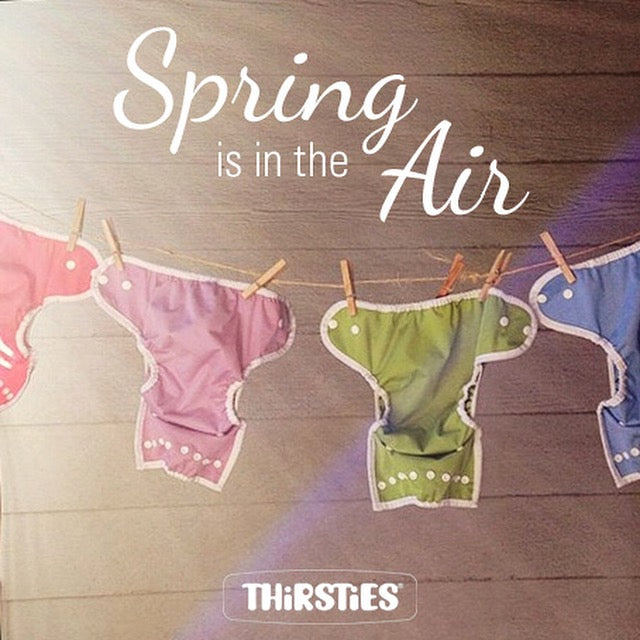With spring comes thoughts of cleaning and freshening up. I've been chipping away at our spring cleaning slower than usual, but I think that's mostly because we spent so much time working to get our old house on the market that our new one still looks, well, like we just moved in. Needless to say, I need to get my rear in gear. So, I thought it'd be fun (if laundry can be deemed fun) to share a few of the most popular topics people ask about when keeping cloth diapers clean, as well as the one and only thing I do to "spring clean" my dipes.
- Once you figure out your routine, stick to it. Do what works best for your family, of course, but this
Thirsties guide is printable (which is super helpful when a well-meaning relative decides to work on laundry while babysitting on a rare date night). Determine whether you have soft or hard water and once you find a routine that works for you, embrace it! Unless you're having issues (like leakage or ammonia smell), don't mess with what's working for you. And don't jump to the stripping conclusion automatically, either - you may need to work out your water's hardness, sizing, or other issues before doing a full strip (which is pretty harsh on cloth if it's not necessary). -
How I "spring clean" my diapers: Embrace the sunshine! On the first warm, sunny day that hits, I make sure to throw in a load of cloth (all of them, if possible, but particularly the ones with stains) to wash as usual. While still wet, I hang them out to get all the disinfecting and whitening benefits of that natural sunshine. (Now that we're at a new house that doesn't have an outside line, I bring my collapsible wood drying rack out and it works just as well. So, if you're in my boat, it's well worth investing in a drying rack!) While a good hot wash will disinfect your dipes, the occasional session in the sun will magically "erase" any of those particularly stubborn stains and do an additional job of getting the nasties out. Make sure they're wet, though, since the "magic" won't work otherwise.
- Looking for a deeper clean? You've got natural options. While I haven't used any of these ideas, you may be facing some additional issues that might make you want to try a deeper disinfection on your cloth. Here are some options (all approved and advised by the team at Thirsties):
Grapefruit Seed Extract - Tests have shown that GSE is dramatically more effective than Colloidal Silver, Iodine, Tea Tree Oil, and Clorox bleach against five common microorganisms. In studies performed by Dr. John Mainarich of Bio-Research Laboratories, samples of each of the common antimicrobials (or sanatizing agents) were evaluated for effectiveness against Candida albicans, Staphylococcus aureus, Salmonella typhi, Streptococcus faecium, and E. coli. The other antimicrobials tested were considerably less than the GSE. 20 drops added to the first rinse cycle should do the trick.
Tea Tree Oil is another option that may be slightly less effective. Add 20 drops to the washer while filling, and make sure you're using 100% Tea Tree Oil.
Vinegar is known to kill germs (although it doesn't kill yeast and isn't recommended for microfiber diapers as it will hold on to the smell). You can use 1 cup of vinegar in the rinse cycle after a hot wash with detergent, then follow with a 25 minute high heat cycle in the dryer.
(Be careful because additives, chlorine bleach, oxygen bleach, pure soap, Borax, high heat in the dryer, and the sanitize/high heat cycles on HE machines can VOID your warranty.) As always, if you ever have a question or concern about your wash routine, check out our Customer Center's
FAQ list and
Cloth Diaper Care page.
In the meantime, let us know - have you ever sunned your diapers? How did it work for you?





